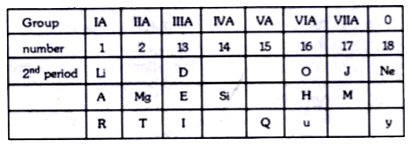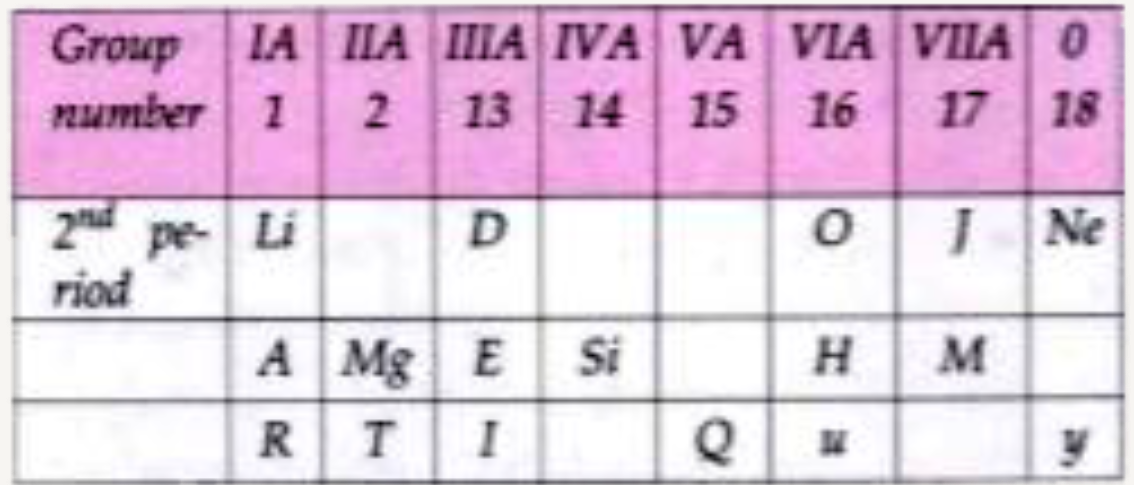Why should hydrogen be assigned a separate position in the periodic table?
Step-by-Step Solution:
1. Understanding Hydrogen's Properties:
- Hydrogen has unique properties that make it similar to both alkali metals and halogens. It can lose one electron to form a cation (H⁺), similar to alkali metals, and it can also gain one electron to form an anion (H⁻), similar to halogens.
2. Comparison with Alkali Metals:
- Alkali metals, located in Group 1 of the periodic table, have one electron in their outermost shell. When hydrogen loses its single electron, it behaves like an alkali metal, forming a positive ion (H⁺). This is significant because it shows that hydrogen can exhibit similar reactivity to alkali metals.
3. Comparison with Halogens:
- Halogens, found in Group 17, have seven electrons in their outermost shell and need one more to achieve a stable electronic configuration. Hydrogen can gain an electron to achieve a configuration similar to helium (1s²), which aligns with the behavior of halogens that also seek to gain an electron to complete their outer shell.
4. Formation of Compounds:
- Hydrogen can form diatomic molecules (H₂) and can combine with both metals and non-metals to create covalent bonds. For example, in water (H₂O), hydrogen forms covalent bonds with oxygen. This ability to form various types of bonds further complicates its classification.
5. Electronic Configuration:
- The electronic configuration of hydrogen is 1s¹. When it loses an electron, it becomes H⁺, and when it gains an electron, it becomes H⁻. This dual behavior indicates that hydrogen does not fit neatly into any one group of the periodic table.
6. Conclusion:
- Due to its unique properties and behavior, hydrogen does not belong exclusively to Group 1 (alkali metals) or Group 17 (halogens). Its ability to exhibit characteristics of both groups, along with its distinct bonding behavior, justifies assigning it a separate position in the periodic table.
- Hydrogen has unique properties that make it similar to both alkali metals and halogens. It can lose one electron to form a cation (H⁺), similar to alkali metals, and it can also gain one electron to form an anion (H⁻), similar to halogens.
- Alkali metals, located in Group 1 of the periodic table, have one electron in their outermost shell. When hydrogen loses its single electron, it behaves like an alkali metal, forming a positive ion (H⁺). This is significant because it shows that hydrogen can exhibit similar reactivity to alkali metals.
- Halogens, found in Group 17, have seven electrons in their outermost shell and need one more to achieve a stable electronic configuration. Hydrogen can gain an electron to achieve a configuration similar to helium (1s²), which aligns with the behavior of halogens that also seek to gain an electron to complete their outer shell.
- Hydrogen can form diatomic molecules (H₂) and can combine with both metals and non-metals to create covalent bonds. For example, in water (H₂O), hydrogen forms covalent bonds with oxygen. This ability to form various types of bonds further complicates its classification.
- The electronic configuration of hydrogen is 1s¹. When it loses an electron, it becomes H⁺, and when it gains an electron, it becomes H⁻. This dual behavior indicates that hydrogen does not fit neatly into any one group of the periodic table.
- Due to its unique properties and behavior, hydrogen does not belong exclusively to Group 1 (alkali metals) or Group 17 (halogens). Its ability to exhibit characteristics of both groups, along with its distinct bonding behavior, justifies assigning it a separate position in the periodic table.
Topper's Solved these Questions
- HYDROGENBOOK - ICSECHAPTER - HYDROGENEXERCISE - VERY SHORT ANSWER TYPE QUESTIONS
45 Videos
- HYDROGENBOOK - ICSECHAPTER - HYDROGENEXERCISE - SHORT ANSWER TYPE QUESTIONS
115 Videos
- HYDROGENBOOK - ICSECHAPTER - HYDROGENEXERCISE - NCERT TEXT-BOOK EXERCISE (With Hints and Solutions)
53 Videos
- HYDROCARBONS BOOK - ICSECHAPTER - HYDROCARBONS EXERCISE - NCERT TEXT-BOOK EXERCISES
46 Videos
- ORGANIC CHEMISTRY : SOME BASIC PRINCIPLES AND TECHNIQUES BOOK - ICSECHAPTER - ORGANIC CHEMISTRY : SOME BASIC PRINCIPLES AND TECHNIQUES EXERCISE - NCERT TEXT-BOOK EXERCISES (WITH HINTS AND SOLUTIONS )
72 Videos
Similar Questions
Knowledge Check
Given below are the names of few elements based on their position in the periodic table. Identify the element which is not correctly placed.
AAn element which tends to lose three electrons-AluminiumBAn element which tends to gain two electrons-lodineCAn element with valency four-SiliconDA transuranium element-plutonium
Comment on the dual position of Hydrogen in the periodic table.
View Solution.................. (Hydrogen / Helium) has the highest ionisation energy in the periodic table.
View SolutionName the element whose properties can be predicted on the basis of its position in the periodic table given by Mendeleev's.
View Solution
• In this table H does not represent hydrogen.
• Some elements are given in their own symbol and position in the periodic table.
• While others are shown with a letter.
With reference to the table answer the following questions :
Identify the noble gas of the fourth period.
View Solution
In the above table - H does not represent hydrogen. Some elements are in their own symbol & position in the periodic table while others are shown with a letter. Identify
The element from period 3 with least atomic size.
View Solution
• In this table H does not represent hydrogen.
• Some elements are given in their own symbol and position in the periodic table.
• While others are shown with a letter.
With reference to the table answer the following questions :
Identify the most electronegative element.
View Solution
In this table H does not represent hydrogen.
Some elements are given in their own symbol and position in the periodic table.
While others are shown with a letter.
With reference to the table answer the question :
Identify the least reactive element of group 1.
View Solution
